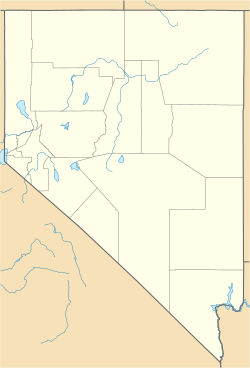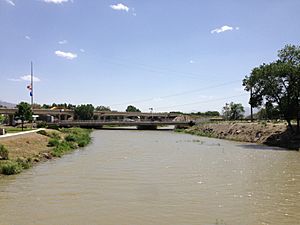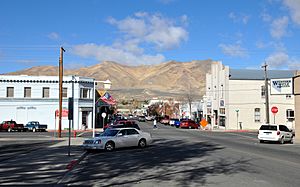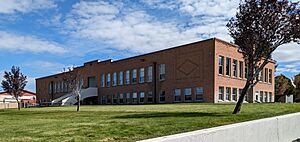Winnemucca, Nevada facts for kids
Quick facts for kids
Winnemucca, Nevada
|
|
|---|---|
|
City
|
|
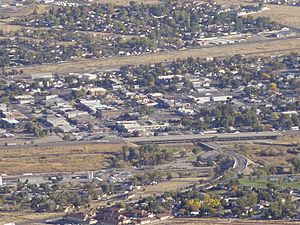
Downtown Winnemucca viewed from Winnemucca Mountain
|
|
| Nickname(s):
City of Paved Streets
|
|

Humboldt County and City of Winnemucca, Nevada
|
|
| Country | United States |
| State | Nevada |
| County | Humboldt |
| Named for | Chief Winnemucca |
| Area | |
| • Total | 9.77 sq mi (25.30 km2) |
| • Land | 9.77 sq mi (25.30 km2) |
| • Water | 0.00 sq mi (0.00 km2) |
| Elevation | 4,295 ft (1,309 m) |
| Population
(2020)
|
|
| • Total | 8,431 |
| • Density | 863.04/sq mi (333.22/km2) |
| Time zone | UTC−8 (Pacific (PST)) |
| • Summer (DST) | UTC−7 (PDT) |
| ZIP codes |
89445–89446
|
| Area code(s) | 775 |
| FIPS code | 32-84800 |
| GNIS feature ID | 0844996 |
| Website | www.winnemuccacity.org |
Winnemucca (![]() i/ˌwɪnəˈmʌkə/) is a city in Nevada, United States. It is the only city in Humboldt County, Nevada and serves as the county seat. This means it's the main town where the county government is located.
i/ˌwɪnəˈmʌkə/) is a city in Nevada, United States. It is the only city in Humboldt County, Nevada and serves as the county seat. This means it's the main town where the county government is located.
As of the 2020 census, about 8,431 people live in Winnemucca. This was a 14% increase from the 2010 census. Major highways like Interstate 80 and U.S. Route 95 meet in the city, making it an important stop for travelers. Winnemucca is also known as "The City of Paved Streets."
Contents
History and Culture of Winnemucca
Winnemucca has a rich history, especially with its connection to Native American tribes and early settlers.
Native American Heritage
The city is named after Chief Winnemucca, a leader of the local Northern Paiute tribe in the 1800s. His name means "the giver." His daughter, Sarah Winnemucca, was a very important person. She spoke out for the rights of the Paiute and Shoshone tribes.
Sarah Winnemucca learned English and worked as an interpreter and scout for the U.S. Army. In 1883, she wrote the first autobiography by a Native American woman. This book is still considered a very important historical account.
Early Transportation and Settlement
The Central Pacific Railroad reached Winnemucca on September 16, 1868. This made Winnemucca a key stop on the first transcontinental railroad. This railway connected the eastern and western parts of the United States.
Basque Culture
Starting in the mid-1800s, many Basque immigrants came to Winnemucca. They often worked as sheep-herders. To celebrate this heritage, Winnemucca holds an annual Basque Festival. It's a fun event that shares their unique culture.
Famous Events
On September 19, 1900, a group led by Butch Cassidy took money from the First National Bank of Winnemucca. This event is part of the city's historical stories.
Winnemucca is also home to the Buckaroo Hall of Fame and Heritage Museum. This museum celebrates the history of cowboys and ranching in the area.
Winnemucca's Chinatown
In the late 1800s and early 1900s, Winnemucca had a lively Chinatown. Many Chinese people first came to the area to work on the transcontinental Central Pacific Railroad. After the railroad was built, some stayed or returned to live in Winnemucca.
Around the 1890s, about 400 Chinese people lived in the town. They had important buildings, like the Joss House on Baud Street. This was a place for worship and celebrations. In 1911, Sun Yat-Sen, who later became the Chinese president, visited the community. He was traveling through the United States to raise money for the Xinhai Revolution in China.
The Joss House was the last building from Chinatown. It was taken down on March 8, 1955.
Geography and Climate
Winnemucca is located at 40°58′6″N 117°43′36″W / 40.96833°N 117.72667°W. The city covers about 24.3 square kilometers (about 9.4 square miles) of land.
Winnemucca has a semi-arid climate. This means it's usually dry, getting only about 8.28 inches of rain each year. Summer days are often hot, but the temperature drops a lot at night. Winters are cold, and it usually snows about 20.9 inches each year.
The hottest temperature ever recorded in Winnemucca was 109°F (43°C) on July 11, 2002. The coldest was −37°F (−38°C) on December 22, 1990. It can even freeze in any month of the year!
| Climate data for Winnemucca, Nevada (Winnemucca Municipal Airport), 1981–2010 normals, extremes 1877–present | |||||||||||||
|---|---|---|---|---|---|---|---|---|---|---|---|---|---|
| Month | Jan | Feb | Mar | Apr | May | Jun | Jul | Aug | Sep | Oct | Nov | Dec | Year |
| Record high °F (°C) | 68 (20) |
74 (23) |
82 (28) |
90 (32) |
98 (37) |
106 (41) |
109 (43) |
108 (42) |
103 (39) |
94 (34) |
77 (25) |
70 (21) |
109 (43) |
| Mean daily maximum °F (°C) | 41.6 (5.3) |
47.5 (8.6) |
55.7 (13.2) |
62.5 (16.9) |
72.2 (22.3) |
82.9 (28.3) |
93.2 (34.0) |
91.3 (32.9) |
80.9 (27.2) |
66.9 (19.4) |
51.4 (10.8) |
41.3 (5.2) |
65.7 (18.7) |
| Mean daily minimum °F (°C) | 18.7 (−7.4) |
22.8 (−5.1) |
26.6 (−3.0) |
30.7 (−0.7) |
37.9 (3.3) |
45.4 (7.4) |
51.8 (11.0) |
48.8 (9.3) |
39.6 (4.2) |
29.5 (−1.4) |
22.4 (−5.3) |
17.4 (−8.1) |
32.7 (0.4) |
| Record low °F (°C) | −36 (−38) |
−28 (−33) |
−3 (−19) |
6 (−14) |
10 (−12) |
23 (−5) |
29 (−2) |
26 (−3) |
12 (−11) |
−2 (−19) |
−10 (−23) |
−37 (−38) |
−37 (−38) |
| Average precipitation inches (mm) | 0.87 (22) |
0.66 (17) |
0.83 (21) |
0.89 (23) |
1.12 (28) |
0.56 (14) |
0.25 (6.4) |
0.18 (4.6) |
0.44 (11) |
0.67 (17) |
0.88 (22) |
0.93 (24) |
8.28 (210) |
| Average snowfall inches (cm) | 3.8 (9.7) |
3.4 (8.6) |
3.2 (8.1) |
1.6 (4.1) |
0.1 (0.25) |
trace | 0.0 (0.0) |
0.0 (0.0) |
trace | 0.5 (1.3) |
3.0 (7.6) |
5.3 (13) |
20.9 (53) |
| Average precipitation days (≥ 0.01 in) | 8.2 | 7.8 | 8.2 | 7.7 | 6.8 | 4.1 | 2.3 | 2.0 | 3.2 | 4.7 | 7.8 | 8.0 | 70.8 |
| Average snowy days (≥ 0.1 in) | 4.7 | 3.5 | 2.7 | 1.9 | 0.2 | 0.0 | 0.0 | 0.0 | 0.0 | 0.5 | 2.9 | 4.6 | 21.0 |
| Average relative humidity (%) | 69.9 | 61.9 | 55.3 | 46.5 | 40.4 | 37.6 | 28.8 | 30.0 | 36.5 | 47.8 | 63.0 | 69.3 | 48.9 |
| Mean monthly sunshine hours | 161.2 | 174.5 | 228.3 | 263.3 | 331.1 | 346.6 | 398.3 | 358.5 | 306.5 | 257.5 | 153.3 | 148.9 | 3,128 |
| Percent possible sunshine | 54 | 59 | 62 | 66 | 74 | 77 | 87 | 84 | 82 | 75 | 51 | 52 | 70 |
| Source 1: NOAA (sun and relative humidity 1961–1990) | |||||||||||||
| Source 2: Weather Channel (extremes) | |||||||||||||
Population and People
Winnemucca has grown steadily over the years. Here's how its population has changed:
| Historical population | |||
|---|---|---|---|
| Census | Pop. | %± | |
| 1870 | 290 | — | |
| 1880 | 763 | 163.1% | |
| 1890 | 1,307 | 71.3% | |
| 1900 | 1,110 | −15.1% | |
| 1910 | 1,786 | 60.9% | |
| 1920 | 1,934 | 8.3% | |
| 1930 | 1,989 | 2.8% | |
| 1940 | 2,485 | 24.9% | |
| 1950 | 2,827 | 13.8% | |
| 1960 | 3,453 | 22.1% | |
| 1970 | 3,587 | 3.9% | |
| 1980 | 4,140 | 15.4% | |
| 1990 | 6,134 | 48.2% | |
| 2000 | 7,174 | 17.0% | |
| 2010 | 7,396 | 3.1% | |
| 2020 | 8,431 | 14.0% | |
| source: | |||
In 2000, there were 7,174 people living in Winnemucca. About 37.8% of households had children under 18. The average household had 2.60 people.
Many people in Winnemucca have German, Mexican, Irish, or English backgrounds. Basque Americans make up 4.2% of the population. This is the highest percentage of Basque people in any city in the United States.
Transportation in Winnemucca
Winnemucca is an important transportation hub.
Rail Travel
Amtrak, the national passenger train system, has a stop in Winnemucca. The California Zephyr train travels through the city every day, connecting San Francisco and Chicago. The train station is at 209 West Railroad Street.
Since 1867, Winnemucca has been a station on the Transcontinental Railroad. This historic railway helped connect the country.
Roads and Highways
Winnemucca is located almost exactly halfway between Salt Lake City and San Francisco. Interstate 80 goes right through the town. U.S. Route 95 also passes through Winnemucca.
Air Travel
The Winnemucca Municipal Airport serves local aviation needs. It's about 5 miles southwest of downtown. There are no regular passenger flights from this airport. For commercial flights, people usually go to Reno–Tahoe International Airport in Reno or Elko Regional Airport in Elko.
Media and News
Winnemucca has its own local newspaper, The Humboldt Sun, which is published twice a week.
There are also several radio stations:
- KHYX-FM (102.7 FM) plays adult contemporary music.
- K232BK (94.3 FM) plays rock music.
- KWNA-FM (25,000 watts) plays country music.
Jobs and Economy
Many people in Winnemucca work for large mining companies, like Newmont and Barrick Gold. Other companies that support the gold mining industry also employ residents. Carry-On Trailers, a manufacturing company, employs over 100 people.
Winnemucca also has a growing tourism industry. Many people work in casinos, hotels, motels, and restaurants. Winnemucca Farms is another big employer. Until 2013, they ran the world's largest potato dehydration plant. The Winnemucca area is still one of the biggest potato farming regions in the world.
Education in Winnemucca
The Humboldt County School District manages the schools in Winnemucca.
There are three elementary schools for grades K-4: Grass Valley, Sonoma Heights, and Winnemucca Grammar School. After elementary school, students attend French Ford Middle School (grades 5–6) and Winnemucca Junior High School (grades 7–8). For high school, students go to Albert M. Lowry High School (grades 9–12). The mascot for Lowry High is the Buckaroos.
Winnemucca also has a public library, which is part of the Humboldt County Library system. For higher education, Great Basin College has a center in Winnemucca.
Notable People from Winnemucca
Many interesting people have connections to Winnemucca:
- Vernon Alley – A famous jazz musician.
- Sharron Angle – A former member of the Nevada Assembly.
- Henry F. Ashurst – A United States Senator from Arizona.
- Mario Bautista – A UFC fighter.
- Howard P. Becker – A sociology professor.
- Bill Berry – A basketball coach.
- Jace Billingsley – A wide receiver for the Detroit Lions.
- George S. Nixon – A United States Senator from Nevada who helped build Winnemucca City Hall.
- Lute Pease – A cartoonist who won a Pulitzer Prize.
- Bob Tallman – A well-known rodeo announcer.
- Ralph V. Whitworth – A businessman and generous giver.
Images for kids
See also
 In Spanish: Winnemucca para niños
In Spanish: Winnemucca para niños


